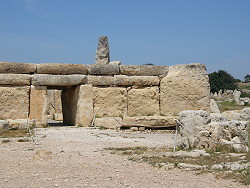 Photo.
Photo. The
facade of Hagar Qim, with
its trilithon doorway. © Travel Explorations.
Malta
has so much to offer for adventurers within a small area. Malta
is located in the heart of the Mediterranean just south of Sicily.
This island and Gozo are filled with traces and mysteries from
ancient time. There are several megalithic buildings around on these islands.
In Malta you can explore the temples Hagar Qim, Mnajdra, Tarxien,
Borg-in-Nadur, ta` Hajrat, and in Gozo you can explore Ggantija, Santa Verna,
ta` Marsiena. These are exceptional monuments that tell a story about how people
lived in the past.
The temple of Hagar Qim was excavated for the first time in 1839. It dates from
the Ggantija phase (3600 - 3200 BC). This temple and other temples on Malta`s islands are about 1000 years older than the
pyramids of Egypt and Stonehenge. Actually it`s believed that the oldest surviving temples are Ta Hagrat
and Skorba near the village of Mgarr on Malta. Hagar Qim and Mnajdra on
the Island on Malta, and Ggantija on Gozo are among the best preserved.
Hagar Qim itself consists of a single temple unit. However, it is not clear
if it was originally constructed as a four- or five-apse structure. Anyway it
was built of soft stone unlike Mnajdra. The temples was originally covered
with roof, but the wooden structures has rotted away for a long time ago.
The most remarkable about Hagar Qim, it`s the impressive and finely-smoothed entrance facade,
for the huge stone blocks used in its construction, and for its associated artefacts:
the "Venus of Malta" and other female statuettes, and a four-sided altar
with plant carvings. The forecourt and facade follow the pattern which
is typical of temples across the islands.
It was exciting to step into the temple where I could
see six large, circular chambers, which were connected by an interior passage. Most
of the chambers have outside entrances, and an open-air shrine is set into
the outer wall. It consists of series of interconnected, oval chambers with no
uniform arrangements, and differs from other Maltese temples in lacking regular trefoil plan.
At the first chamber at left I could see a little altar post decorated
with plant motifs, and in the second there are a couple of pedestal altars.
Photo. Remarkable stone builders. The largest
megalith at Hagar Qim is about seven metres high and weights around 20 tons. How
did the people manage to transport and set up this stone?
According to the website Heritage of Malta (www.heritagemalta.org), much of
interest has been unearthed at Hagar Qim, especially a decorated pillar altar, two table-altars and some of
the Fat Lady statues, which is displayed in the National Museum
of Archaeology in Valletta. The Fat Ladies statues is though to be symbolic, possible
fertility goddesses.
Photo. Stone altar
and stone slab with spirals.
Photo. Slab on end is 6.40 metres long
It was not any coincidence that people in ancient time constructed these temples at this site. They
lived in a sunny climate and wanted to be near the sun as possible so they
could conduct their religious rites. It's believed that the people at that
time where worshippers. For these people I believe Malta was just perfect. Much have
changed since the temples were built, but Malta has kept its sunshine. Today
Malta has a typically Mediterranean climate, with mild winters, hot dry summers and about
300 sunny days.
As far I could see there were no indication for that the rooms inside Hagar
Qim were intended for dwelling and personal comfort. So it has probably not been
built for housing people or serves as a palace.
Since it was an altar there in one of the chambers, it's likely that the building has
been used as a sacrificial place. No tombs have been found here either. So it has
definitely not been used as a burial place.
So back to one of the main
questions: why is the earliest evidence for the use of stone for building
purposes found in Malta`s small islands? I walked around in the beautiful scenery looking for other ancient traces
that could be the remaining pieces in the puzzle, but it was hard to come up
with some reasonable answers. Sometimes you just have to admire the wonders with
thinking too much.
Read more on part 2: Coming up!
Stein Morten Lund, 7 May 2006
Additional information
Website for
Heritage Malta: www.heritagemalta.org
Read more
articles about Malta on our website Travel
Explorations.
There will the coming weeks be published several
articles about Malta. Also video clips from great adventures and explorations
from our journey on Malta will be available on Travel
Explorations.





 Photo. The
facade of Hagar Qim, with
its trilithon doorway. © Travel Explorations.
Photo. The
facade of Hagar Qim, with
its trilithon doorway. © Travel Explorations.






